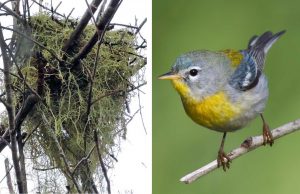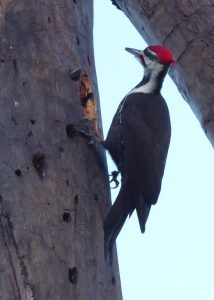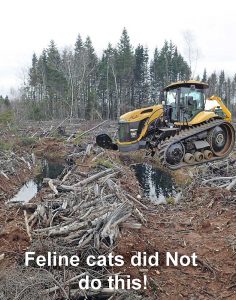
…but maybe a CAT tractor did. “I suppose an analogy [to the in-Nova Scotia- cats-kill-more-forest-birds-than-clearcutting story] would be: Who would be more responsible for the decline of Monarch butterflies, the person who shoots one million butterflies out of the air every migration or the person who burns up all the milkweed without actually killing any butterflies?” – JT.
Click on image to enlarge
Contents
1. NSDNR responses to concerns about impacts of clearcutting on forest birds
2. Studies on direct, human caused mortality of birds in Canada
3. Habitat loss/degradation is the major contributor to decline of many species
4. Clearcutting can increase or decrease bird diversity at large depending on the existing mix of young/old forest
5. NSDNR has been slow in implementing Landscape Level Planning for Biodiversity Conservation
6. Soil acidification/low base saturation/calcium depletion a major threat
7. Conclusion
8. More links
9. Some of the comments on WWNS
1. NSDNR responses to concerns about impacts of clearcutting on forest birds
Back in January, the Chronicle Herald’s John McPhee wrote an article about the efforts of Neal Livingston of the Margaree Environmental Association to highlight the loss of bird nests from clearcutting in Nova Scotia. Neal cited stats from an article I had listed under Natural History>Birds: An Estimate of Nest Loss in Canada Due to Industrial Forestry Operations by K.A. Hobson et al.,2013. Avian Conservation and Ecology 8(2): 5.
From the McPhee in Environmentalists worried about potential forestry-related nest loss, CH Jan 3, 2018):
The study, based on 2013 statistics, concluded that between 214,500 and 1.69 million nests are lost each year as a result of logging across Canada.
Given that most bird nests contain between two and four eggs or hatchlings, that adds up to a big loss of bird life, Livingston said in a recent interview.
...Livingston said the negative effects on bird life from forestry contravenes Nova Scotia’s commitments under the Migratory Birds Conventions Act.
Better planning around harvesting during breeding time and more selective harvesting techniques other than clearcutting could reduce the bird toll, said Livingston, a woodlot owner in Mabou who received awards for his selective harvesting approach.
McPhee asked NSDNR for comment; he wrote (bolding mine)
The provincial Department of Natural Resources said its biologists, wildlife technicians and other specialists work to manage Nova Scotia bird populations and their habitat.
“The department is actively engaged in undertaking and supporting research on birds in forested landscapes,” spokesman Bruce Nunn said in an email Wednesday.
“Bird populations and habitat are impacted by many human activities on the landscape and forestry is not among the most significant source of impacts” compared to cat predation, housing and road development, and vehicle collisions.
The department has guidelines encouraging protection of raptor nests and species including Bicknell’s thrush, Canada warbler, chimney swift and the common nighthawk, and others.
The DNR also considers bird conservation in project reviews such as environmental assessments. Nunn also referred to the department’s Agricultural Biodiversity Conservation program that promotes best farming practices that reduce impacts to birds.
Subsequently, Livingston/the Margaree Environmental Association erected several billboards in Halifax, with the heading “80,000 bird nests destroyed last year” and appealing to viewers to ask Premier McNeil to Stop Clearcutting. Stuart Peddle of the Chornicle Herald wrote about it in Environmental group calls for end to clearcutting, billboards focus on bird nest destruction (Apr 2, 2018). Like McPhee, he also asked NSDNR for a response and received a near identical one to that received previously, but this time from Bob Petrie, director of wildlife division (bolding mine):
Bob Petrie, director of wildlife division, Department of Natural Resources, said in a statement the department has biologists, wildlife technicians and other specialists who work to manage Nova Scotia bird populations and their habitat.
“The department is actively engaged in undertaking and supporting research on birds in forested landscapes,” the statement said. “DNR also delivers the Agricultural Biodiversity Conservation program to promote best farming practices that reduce impacts to birds.”
The department said bird populations and habitat are affected by many factors.
“Environment Canada statistics show that a significantly greater number of birds are lost to feral cats, collisions with houses and powerlines, and vehicle strikes,” the statement said.

Cape May warbler
(Dick Daniels onWikipedia)
In a similar vein, loss of biodiversity associated with clearcutting did not make it in the initial list of potential topics for regulation under the impending Biodiversity Act (curiously, coming under NSDNR, not under NSE) – view post of June 4, 2018
So is it all that simple and obvious that NSDNR can essentially dismiss concerns about loss of birds (and other wildlife) associated with clearcutting because the science, according to NSDNR, says a significantly greater number of birds are lost to feral cats, collisions with houses and powerlines, and vehicle strikes?
I don’t think so.
2. Studies on direct, human caused mortality of birds in Canada
The Environment Canada stats in which NSDNR finds refuge are found in the same set of research studies containing the paper cited by Livingston:
Quantifying human-related mortality of birds in Canada
Avian Conservation and Ecology 8 (2), 2013. It includes 9 research papers:
-Estimates of Avian Mortality Attributed to Vehicle Collisions in Canada
-Estimated number of birds killed by domestic cats ( Felis catus ) in Canada
-Mortality of Migratory Birds from Marine Commercial Fisheries and Offshore Oil and Gas Production in Canada
-An Estimate of Nest Loss in Canada Due to Industrial Forestry Operations
-A First Estimate for Canada of the Killed by Colliding with Building Windows
-Avian mortalities due to transmission line collisions: a review of current estimates and methods with an emphasis on applications to the Canadian electric network
-Estimated Mortality of Selected Migratory Bird Species from Mowing and Other Mechanical Operations in Canadian Agriculture
-Estimated Avian Nest Associated with Oil and Gas Exploration and Extraction in the Western Canadian Sedimentary Basin
-Canadian Estimate of Bird Mortality Due to Collisions and Direct Habitat Loss Associated with Wind Turbine Developments
together with a Guest Editorial and a A Synthesis of Human-related Avian Mortality in Canada.
These are comprehensive, intensive investigations which combine a lot of observations with a lot of statistics and a lot of assumptions and a lot of modelling and are not easy reading. The synthesis alone is 214 pages.
The key estimates are these:
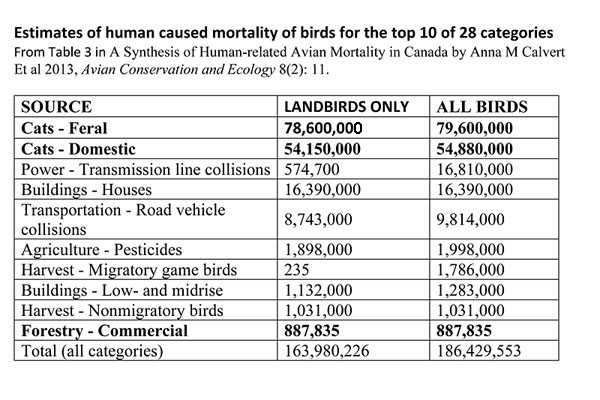 So these stats do indeed indicate that cats kill, directly, about 150 times as many birds as commercial forestry, and the Press picked up on that conclusion, e.g.,
So these stats do indeed indicate that cats kill, directly, about 150 times as many birds as commercial forestry, and the Press picked up on that conclusion, e.g.,
Leading causes of bird deaths in Canada
CBC News , Oct 01, 2013 “Cats are the No. 1 culprit, followed by collisions with tall structures”
I guess that is all Mr. Petrie felt that was all that is appropriate to cite about the study when he stated:
“Environment Canada statistics show that a significantly greater number of birds are lost to feral cats, collisions with houses and powerlines, and vehicle strikes”
Go into the studies themselves and we learn what should be obvious to people like Mr. Petrie: (i) cats take some species more than others; (ii) the upward or downward trend in the population of a particular species may have no relation to the magnitude of direct human caused mortality.
For example, in regard to (i), from the Belcher paper, Estimated Number of Birds Killed by Cats House ( Felis catus ) in Canada, (bolding mine):
- Of 461 bird species that regularly occur in Canada, 115 (25%) were identified as potentially vulnerable to cat predation on the basis of presence in southern Canada, and nesting and foraging characteristics
- Twenty-three species at risk in Canada (COSEWIC 2012) are among the potentially vulnerable species…all of these birds nest on or close to the ground in open landscapes in southern Canada, two on islands…Predation by cats is mentioned as a concern in status reports or recovery plans for at least 10 of these species, though in no case are house cats listed as the primary threat to population viability.
- Among mainland populations of birds, species that nest or forage on or near the ground tend to be overrepresented in cat prey relative to other birds…Birds that are found in or near residential neighborhoods or farms, or that frequent bird feeders, are also likely to be found among prey of house cats…Because pet cats tend not to penetrate far into forests (Kays and DeWan 2004), birds of interior forests are less likely to be vulnerable to cat predation even if nesting or foraging on the ground. For instance, cats were not among 12 predators filmed at 42 Wood Thrush (Hylocichla mustelina) nests in fragmented forests of southern Ontario despite proximity to farms and residential developments (L. Friesen, personal communication).
So, cats are NOT significant predators on 75% of the bird species; or on 13 of 23 SAR (species at risk) in Canada; and the most threatened forest birds, those of the forest interior are NOT, in general, predated on by cats. (However many of those are subject mortality by hitting human created structures during migration).
In relation to (ii), it is also repeatedly emphasized in these studies that (bolding mine)
… most analyses presented here were designed to estimate direct annual kill of individual birds or destruction of nests. Estimates for most mortality sources that also involve significant clearing or alteration of habitat do not reflect the total long-term impact of the activity on bird populations because most analyses did not account for additional long-term impacts, e.g., via habitat change (Synthesis Paper PDF page 14)
This underscores a key point about the stats apparently not appreciated by NSDNR: there is not a simple relationship between the human-induced mortality rates and long term changes in bird populations. There are cases where cats have driven some local populations of particular species to local extinction (“extirpation”) or even whole species but those are very species- and situation-specific, e.g. some species on islands after cats are introduced.
In addition to direct, human caused mortality, any one or more of a wide range of factors may determine whether a species is stable, increasing or decreasing such as climate change, weather during migrations, habitat change on the wintering grounds (for migratory species), and habitat change on the breeding grounds. It can be difficult to determine the causes of change in abundance for a particular species.
3. Habitat loss/degradation is the major contributor to decline of many species
In regard to landbirds generally, however, the ornithological community is unanimous: habitat loss/degradation is the major contributor to decline of many species.
E.g.from the Cornell Lab:
Q: If You Want To Save Birds, Then You Should Work On The Multitudes Of Problems Humans Have Caused That Are Far More Devastating To Birds.
A: You are right that in order to save birds, we must address many challenges that are driving declines in birds. The Cornell Lab of Ornithology takes a multifaceted approach. Habitat loss and degradation are the biggest threats, and we work within the United States and with international partners to identify and protect critical areas for birds. In North America, cats are second only to habitat loss as the largest human-related cause of bird deaths. It’s estimated that cats kill 1.3–4 billion birds each year in the U.S. alone, with 69% of these kills attributable to feral or unowned cats. This is a staggering number even when compared with the next-largest sources: 599 million estimated to be killed in collisions with windows and 200 million killed by automobiles.
From Sibleys Guides:
First, it should be stated that the single most significant threat to bird populations is habitat destruction, in all of its forms and with all of its causes. The various causes of mortality outlined below* kill individual birds directly, and can certainly have an adverse effect on population size, but can actually have a beneficial effect in some cases. Studies of hunting have documented that in certain cases killing small numbers of birds can improve the health and survival of the remaining birds. As long as the habitat is intact, the population has the potential to replace the lost birds.
In simplest terms, habitat destruction reduces the population by reducing the available resources, denying birds the chance to reproduce, and effectively putting a cap on the population size. The problems outlined below* are serious threats and are implicated in the declines of many species. They should be addressed.
_____________
*Collisions – Window strikes, Communication towers, High tension line collisions, Electrocutions, Cars, Wind turbines; Poisoning – Pesticides, Oil spills, Oil and wastewater pits, Lead poisoning, Pollution; Predation – Hunting, Domestic and Feral Cats, By-catch; Disease.
From PARTNERS IN FLIGHT LANDBIRD CONSERVATION PLAN 2016 Revision for Canada and Continental United States:
Several major large-scale forces threaten birds in every region and habitat in North America. In this section, we take a close look at how these factors result in elevated threat scores in the Partners in Flight (PIF) vulnerability assessment for landbirds of continental importance with breeding populations in the U.S. and Canada.
…Our analysis indicates that the two most pervasive threats to landbirds in the U.S. and Canada are habitat loss due to urbanization and habitat degradation due to changing forest conditions. Both of these threats affect almost half (44-45 species) of the 98 Watch List and Common Birds in Steep Decline
It is also noted:
Private and public forests managed for commercial timber production provide important habitat for most forest bird species. The distributions of these species are largely on private lands in eastern forests, while public lands play a larger role in western forests. These working forests typically consist of a mix of forest ages, types, and structures, and provide a shifting mosaic of forest conditions required by a number of declining, disturbance-dependent birds. When commercial forest lands are adjacent to other ownership types, all ownerships have the potential to complement each other and deliver habitat diversity to benefit birds across landscapes.
From: Forest Bird Populations in Massachusetts: Breeding Habitat Loss and Other Influences
Timothy J. Gardner et al. 2017. Northeastern Naturalist 24(3):267-288
Abstract
Our objective was to determine whether changes in populations of forest-interior bird species were related to changes in extent of interior forest along Breeding Bird Survey (BBS) census routes in Massachusetts. We first identified a suite of 28 forest-interior bird species (FIA species), based on correlations between bird abundance (in 2003–2007) and extent of interior forest (in 2005) along BBS routes. From this group, we eliminated 13 species whose breeding habitats were described in the literature as including forest edge or second growth, resulting in a more stringently defined subset of 15 (FIB) species. We quantified the extent of forest and interior forest (>100 m from a forest edge) along BBS routes based on digitized aerial photographs from 1971, 1985, and 1999. We also quantified changes in abundance of the 28 forest bird species along BBS survey routes over the same time period. Overall, changes in abundance of FIB species paralleled changes in extent of interior forest, with 13 of 15 species showing positive correlations, 5 of which were significant. However, substantial variation occurred among species, including conspicuous declines in Hylocichla mustelina (Wood Thrush) and Piranga olivacea (Scarlet Tanager) and conspicuous increases in Vireo solitarius (Blue-headed Vireo) and Setophaga coronata (Yellow-rumped Warbler). Changes were not significantly related to either migratory status (Neotropical vs. other) or nest location (ground vs. arboreal). Several differences could be attributed to species-specific factors, such as reintroductions of Meleagris gallopavo (Wild Turkey) and Corvus corax (Common Raven) or introduction of competitors, such as Haemorhous mexicanus (House Finch) impacting Haemorhous purpureus (Purple Finch). Changes in some bird populations seem to reflect forest succession, e.g., Hylatomus pileatus (Pileated Woodpecker), while others are unexplained and may be due to changes on migratory routes or wintering grounds. Overall, loss of interior forest is an important incremental factor in forest bird population declines, although other factors had a greater impact in the period under study.
 Thus the NSDNR statements highlight mortalities without citing the critical role of habitat loss are impacted by many human activities on the landscape and forestry is not among the most significant source of impacts. Further, in a discussion of the development of a Biodiversity Act, NSDNR personnel contended that current restrictions on harvests are sufficient to protect biodiversity (Post, June 4, 2018)
Thus the NSDNR statements highlight mortalities without citing the critical role of habitat loss are impacted by many human activities on the landscape and forestry is not among the most significant source of impacts. Further, in a discussion of the development of a Biodiversity Act, NSDNR personnel contended that current restrictions on harvests are sufficient to protect biodiversity (Post, June 4, 2018)
Given the larger context of the study cited by NSDNR, reviewed above, NSDNR’s statements suggest that their personnel have confused causes of direct mortality and causes of bird decline, apparently equating them. A more cynical interpretation could be that NSDNR has chosen not to highlight the significance of habitat loss through clearcutting on short rotations because it would reflect badly on NSDNR forest policies.
Either way, the result is that NSDNR has not properly represented the science in their response to concerns about nest losses associated with clearcutting.
When you step back and think about the NSDNR statements, one has to wonder… “Bird populations and habitat are impacted by many human activities on the landscape and forestry is not among the most significant source of impacts” and “Environment Canada statistics show that a significantly greater number of birds are lost to feral cats, collisions with houses and powerlines, and vehicle strikes” it is simply ludicrous.
How could “feral cats, collisions with houses and powerlines, and vehicle strikes” be more damaging to habitat than clearcutting?
4. Clearcutting can increase or decrease bird diversity at large depending on the existing mix of young/old forest
It’s important to recognize that clearcutting itself is not necessarily bad for land birds in general. There is a suite of species associated with early successional stages of forests, and a suite associated with later stages (e.g. view Forests succession, deadwood and OG Species at Risk).
There can be situations where a forest has few early successional patches and some clearcutting (or other form of disturbance) is actually beneficial, e.g. in much of Northern New England there is a relative sparsity of young forest, and in such forests, some clearcutting can boost overall biodiversity.
Higher bird abundance and diversity where American woodcock sing: Fringe benefits of managing forests for woodcock
Roger J. Masse et al., 2015. Journal of Wildlife Management 79: 1378-1384. “Declines of early‐successional forest across the northeast United States during the past 60 years has caused declines in populations of associated birds and active forest management is necessary to reverse these trends…”Age before beauty – Grants bring attention to need for ‘young forests’ in N.H.
David Brooks in Concord Monitor, Oct 9, 2017. “We don’t have a lot of age diversity in our forests,” said Scott Hall, a senior bird conservation biologist for the National Fish and Wildlife Foundation, noting that most of New England’s forest were cut a century ago for logging or farmland and have since grown back. “We have a resilience problem when all the trees you have are 60 to 100 years old. You need more diversity.”
Such is clearly NOT the case in Nova Scotia which is probably the most intensively harvested forest landscape in Canada with less than 1% late-successional old-growth forest remaining.
Degradation of our forests began with the arrival of the European settlers. As much as 50% or more of the Pre-Columbian forest of Nova Scotia and region “may have been dominated by late-successional old-growth forest types over the 4000–5000 years before European settlement,” with the remainder of the forest in earlier successional stages following disturbance, mainly wind ( Mosseler et al. 2003 Old-growth forests of the Acadian Forest Region Environmental Reviews 11: S47-77)
More recently, the introduction of widespread industrial clearcutting in the late 1950s/1960s has drastically reduce the cover by remaining older forest.
In 2001, GPIAtlantic reported that, based on the NSDNR forest inventory data dating back to 1958, there had been a sharp decline in the percentage of forests aged 61 and over, a significant loss in age diversity, and a sharp shift from older to younger age classes during the roughly 40-year period. For example, the GPI report found that in 1958, one-quarter of Nova Scotia’s forests were over 80 years of age, with this percentage declining dramatically to just 1% four decades later. By contrast, young forests (up to 40 years old) more than doubled in this time period from just 12% of the total in 1958 to 32% at the end of the 1990s. In a single generation, therefore, the age composition of Nova Scotia’s forests changed dramatically, and the Province lost almost all its remaining old forests‹with true old growth (forests more than 100 years old) now virtually non-existent.
…According to the most recent GIS inventory data provided by the NSDNR, the youngest age class (0 to 20 years), which includes those stands that have been clearcut, has increased considerably as a proportion of total forest cover since GPIAtlantic’s 2001 report, from 16.3% of the province’s forests in 1999 to 23.9% in the 1997-2003 inventory. In the early 1970s, such very young forest stands constituted only 3.8% of the Province’s forests, and this proportion has been increasing ever since‹with the largest percentage point increase in the most recent period. – GPI Forest Headline Indicators for Nova Scotia by Linda Pannozzo and Ronald Colman. May 2008. GPI Atlantic.
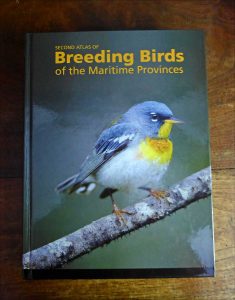 The Second Atlas of Breeding Birds of the Maritimes comments on changes between the first Atlas of Breeding Birds of the Maritimes [1986-1990, published 1992] and the 2nd Atlas [ 2006 to 2010, published 2016] and is clear that “Declining area of older forest is probably the largest single problem facing forest bird conservation”:
The Second Atlas of Breeding Birds of the Maritimes comments on changes between the first Atlas of Breeding Birds of the Maritimes [1986-1990, published 1992] and the 2nd Atlas [ 2006 to 2010, published 2016] and is clear that “Declining area of older forest is probably the largest single problem facing forest bird conservation”:
The period between the first and second atlases has seen a
decline in the amount and distribution of older forest attributes,
such as large trees, well-developed canopies, and significant
numbers of large dead and dying trees. Though the rate varies
according to markets and by ownership, tree harvesting
continues to reduce the area of older forest more quickly than
older forest characteristics are being created. Where forests
are managed to maximize the amount of wood that can be
harvested, older forest will continue to be severely reduced
and will be maintained at that reduced level into the future.
Without explicit consideration for the amount and distribution
of older forest attributes, forest management generally results
in very low amounts of older forest on the landscape. Declining
area of older forest is probably the largest single problem facing
forest bird conservation, because many birds require attributes
of older forest.
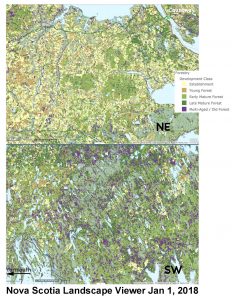
Old forest is sparse and highly fragmented, less so in SW Nova Scotia but that is where WestFor anticipates extensive cutting
5. NSDNR has been slow in implementing Landscape Level Planning for Biodiversity Conservation
Clearly, there needs be a reduction in the amount of clearcutting annually and more retention of old forest just to maintain and, more desirably, to increase levels of forest bird biodiversity.
Additionally, at this juncture, the remaining patches of old forest are highly fragmented, a recipe for loss of biodiversity even if clearcutting is greatly reduced.
We are only just at the beginning of large scale species losses associated with fragmentation of habitat. The alarm bells about species loss were raised in the 1980s because of losses that had occurred until then and, more so, because a better theoretical understanding of species biodiversity predicted huge losses to come with continuing destruction and fragmentation of habitats. E.O. Wilson’s rule of thumb predicts that a tenfold reduction in habitat results in approximately 50% reduction in the number of species an area can support. Many or most species may hang on in a remnant habitat for a while, but are lost as they become locally extinct and cannot be replaced by immigration from other, still extant populations in other suitable habitats.View Conservation on this website for discussion of fragmentation… View more on this topic under Natural History> Conservation
SW Nova Scotia has the highest concentrations of older forest (see maps above), but this is where WestFor is desperate to cut much of it (view Western crown lands).
With or without a reduction in clearcutting, landscape level planning and management to increase connectivity between old forest patches and larger core areas is essential to reduce the longer term effects of fragmentation on biodiversity. While NSDNR had conducted much of the field documentation, produced maps and developed tools for landscape level planning by 2008, it has yet to implement landscape level planning in its Crown land management protocals, or to provide the models that might be used by private woodlot managers or by certifying organizations. I learned just recently via an article in the March 2018 Atlantic Forestry Review (see post, Mar 30, 2018) that a pilot project was initiated in 2017, so full implementation is likely a few years away at best.
6. Soil acidification/Low base saturation/low calcium/ is a major threat to biodiversity
An additional and, in one sense, even more fundamental threat to forest biodiversity at large in Nova Scotia that has been largely under the radar is the soil acidification*/low base saturation/low calcium status of much of the forested soils of Nova Scotia. This issue was clearly shown and mapped by aquatic scientists in the mid-2000s. A NSDNR sponsored thesis by Joshua Noseworthy, 2011 (never released or announced by NSDNR, but available after a couple of years via a UNB website), and a journal paper by Kevin Keys et al. in 2016 confirmed the findings of the aquatic scientists and elaboarted on them in relation to forestry.
_____________
*Most soils in Nova Scotia are naturally acidic, the exceptions being mostly those developed on limestone and gypsum, “soil acidification” refers to increased acidification/lower pH which can be damaging by increasing mobility of aluminum and mercury.
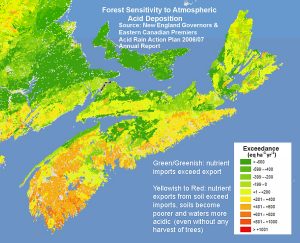
From: Miller, E. et al. 2007. Mapping Forest Sensitivity to Atmospheric Acid
Deposition. Conference of New England Governors and Eastern Canadian Premiers Forest Mapping Group Report.
Like acid rain, forest harvesting removes basic cations from forest soils and could be expected to exacerbate acid rain effects &/or lead to declines in nutrient reserves even in the absence of acid rain on some sites. Keys et al. 2016 note that “harvest removals can exacerbate declines in base cation levels (especially Ca) in affected soils.” For stem only-clearcuts, Noseworthy’s results indicate an average 52% increase in Base Cation Depletion over the background acid rain effect averaged for all of Nova Scotia. The results also indicate that “there are stands within the province which would be subject to harvest-induced nutrient losses, without the added strain of soil acidification,” but further details are not given.
The focus of Keys et al., 2016 research is on nutrient budgeting for assessing forest harvest sustainability across Nova Scotia. They comment on some of the impacts of low base saturation and low calcium in particular on forest productivity but do not comment on the effects on aquatic systems identified by aquatic scientists going back to the 1980s in relation to precipitous declines in salmon, nor do they comment on effects on forest biodiversity, nor is such information to be found on the NSDNR wesbsite.
In addition to the well known effects of calcium loss and aquatic acidification on salmonids, many studies are emerging showing that declines in calcium under forests are having diverse adverse effects either through calcium deficiency directly or indirectly through reduced pH, aluminum mobilization and enhanced mercury toxicity e.g., on cold tolerance of red spruce1 , sugar maple decline1,2, forest salamanders and snails3 , loon reproduction4 , zooplankton5 , forest herbs6 , invertebrates and song birds7.
_______________________
1. M. E. Fenn et al. 2006. Status of soil acidification in North America Journal Of Forest Science, 52 (Special Issue): 3–13. 2. Schaberg, P.G., J.W. Tilley, G.J. Hawley, D.H. DeHayes, and S.W. Bailey. 2006. Associations of calcium and aluminum nutrition with the growth and health of sugar maple trees in Vermont. Forest Ecology and Management 223:159-169. 3. C.M. Beir et al. 2012. Changes in faunal and vegetation communities along a soil calcium gradient in northern hardwood forests. Canadian Journal of Forestry Research 42: 1141–1152. 4. Bird Studies Canada. 2013. The Canadian Lakes Loon Survey 1981-2012. Accessed Feb 9, 2013 at www.birdscanada.org/volunteer/clls/resources/CLLSsummary.pdf. 5. A. Jeziorski, et al. 2008. The widespread threat of calcium decline in fresh waters. Science 322, 1374 6. N. M. Hill & D.J. Garbary 2011 Habitat may limit herb migration at the northern edge of the Appalachian deciduous forest Botany 89: 635-645. 7. S.E. Pabian & M.C. Brittingham. 2012. Soil calcium and forest birds: indirect links between nutrient availability and community composition. Ecosystems 15: 748–760.
While forest calcium deficiency issues associated with acid rain have been widely recognized in northeastern North America, Nova Scotia is especially prone to such deficiencies because our soils have some of the lowest weathering rates (and hence lowest capacity to replace calcium and other basic cations) amongst soils of Europe and eastern North America1. In contrast to other regions, our surface waters which are now some of the most acidified in North America have been slow to respond to emission controls2.
_______________________
1. C.J. Whitfield et al., 2006. Comparison of weathering rates for acid-sensitive catchments in Nova Scotia, Canada and their impact on critical load calculations Geoderma 136; 899–911).
2. T.A. Clair et al. 2011.Water chemistry and dissolved organic carbon trends in lakes from Canada’s Atlantic Provinces: no recovery from acidification measured after 25 years of lake monitoring. Canadian Journal of Fisheries and Aquatic Sciences 68(4):663-674
That doesn’t mean we cannot have biodiverse, productive forests – witness the few old growth stands that we still have, successful cases of multi-aged management for hardwood timber, and growing markets for non-timber resources from our forests. But it does mean that we cannot clearcut them again and again without penalty. We are already paying the penalties.
Remarkably, in 2018, NSDNR has yet to implement any consideration of nutrients in Crown land harvest decisions or even to highlight the issue as one that we need to be very concerned about. The issue remains almost invisible on the NSDNR website. (View Lessons from New Hampshire: clearcutting on acidified soil reduces sugar maple regeneration, favours beech Posted on April 1, 2018 by admin; Calcium Depletion, page on this website.
7. Conclusion
 Why is it that NSDNR which has a large scientific staff with some very capable people could so misinterpret or misrepresent the threats to forest birds, represented by the statements “Bird populations and habitat are impacted by many human activities on the landscape and forestry is not among the most significant source of impacts” and “Environment Canada statistics show that a significantly greater number of birds are lost to feral cats, collisions with houses and powerlines, and vehicle strikes”?
Why is it that NSDNR which has a large scientific staff with some very capable people could so misinterpret or misrepresent the threats to forest birds, represented by the statements “Bird populations and habitat are impacted by many human activities on the landscape and forestry is not among the most significant source of impacts” and “Environment Canada statistics show that a significantly greater number of birds are lost to feral cats, collisions with houses and powerlines, and vehicle strikes”?
Two factors that may be involved: (i) A conflict of interest inherent to the mandate of the Renewable Resources Branch of NSDNR which includes both helping the forest industry and ensuring conservation and sustainable use of wildlife; and (ii) the very limited interaction of NSDNR scientific staff with the larger scientific community and the public.
Until such issues are addressed it seems little action will be taken to properly protect forest birds and forest biodiversity more generally in Nova Scotia.
I would be pretty surprised (and disappointed) if such issues are not addressed in our anxiously awaited report from the Independent Review of Forest Practices in Nova Scotia.
In the interim, or perhaps regardless, I felt NSDNR’s claim that cats are more hazardous to forest birds than clearcutting, however obvious the reality might be to most, needed to be addressed.
8. More Links
A Land Manager’s Guide to Improving Habitat for Forest Thrushes
Kenneth V. Rosenberg et al., 2003. Cornell Lab of Ornithology, 32 pages.
This guide is focused on improving habitat for five forest-dwelling thrushes, including the Veery (Catharus fuscescens), Swainson’s Thrush (Catharus ustulatus), Hermit Thrush (Catharus guttatus), Wood Thrush (Hylocichla mustelina), and Varied Thrush (Ixoreus naevius). Providing well-managed habitat for these wide-ranging species that use a variety of forest habitats also will benefit a host of other forest birds. We first offer a series of general management guidelines that are applicable in both eastern and western landscapes. These include preventing the fragmentation of large forest tracts, minimizing the creation of edge habitats, establishing forested corridors to reduce isolation of small patches, and maintaining structural and plant-species diversity within existing forests. Unlike tanagers, thrushes are birds of the forest understory, requiring dense shrub or sapling layers and a well-developed layer of leaf litter on the forest floor. These conditions exist in some mature and old-growth forest types, but most often are enhanced by small-scale disturbances within forested regions. Silvicultural practices that mimic natural disturbance and promote deciduous shrubs and saplings can benefit thrush populations, as long as overall forest cover in a landscape is not permenantly reduced. In all forested regions, general guidelines for thrushes and other forest species include: (1) maintaining large and unfragmented forest blocks; (2) promoting understory growth through natural disturbance or management; and (3) limiting overbrowsing by deer, livestock, and other ungulates. In the western region, protection and enhancement of riparian forest are critical for thrush and other bird populations. In eastern and northern forests, patches of 150 acres (62 ha) or larger generally will provide thrushes with high to moderate levels of habitat suitability
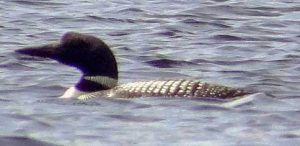 Complex, old-growth forests may protect some bird species in a warming climate
Complex, old-growth forests may protect some bird species in a warming climate
Science News, December 15, 2017. “Old forests that contain large trees and a diversity of tree sizes and species may offer refuge to some types of birds facing threats in a warming climate, scientists have found.”
New Brunswick forestry practices impact bird populations, says researcher
Terrence McEachern, CBC News,Dec 18, 2016. “A large new plantation may contain fewer opportunities for feeding and nesting”
Loon Lake clearcuts continue, illustrate lack of landscape level planning
Post 0n nsforestnotes.ca, Feb 11, 2018
Science issues and lack of landscape/watershed level planning by Nova Scotia DNR limit what can be achieved through forest certification
Post 0n nsforestnotes.ca on February 11, 2018
Show us the science behind clearcuts on Crown land close to the pending Shingle Lake Nature Reserve, Nova Scotia
Post on nsforestnotes.ca, Aug 9, 2017, “Clearcutting close to the pending Shingle Lake Nature Reserve illustrates transparency issues & raises questions about landscape level planning for biodiversity conservation in Crown land harvest decisions”
Bird Conservation Strategy for region 14 in Nova Scotia and select marine units
Environment and Climate Change Canada, 2013. “There is a variety of current and potential threats to the region’s avifauna. Many of these threats are related to land use and, in particular, forestry and agricultural activities and include: loss or fragmentation of all forest types because of logging activities; loss or fragmentation of habitats due to conversion into farmlands; decreases in diet quality, in the health of birds, or in prey availability due to the contamination of food sources from biocides used in the forestry or agricultural industries. There is also a variety of threats related to urban or recreational housing expansion along the coastline including loss of habitat, human disturbances along the coast and shoreline protection of coastal infrastructure (such as roads and houses).”
SURETTE: Natural Resources, torn between conservation and clearcutting, must be split up
Ralph Surette in Chronicle Herald, Sep 19, 2014
Nova Scotia’s Clearcut Refugees
Post on nsforestnotes.ca, Mar 12, 2017
Crossland: federal Migratory Birds Convention Act ignored as habitat is cut for chips
Post on nsforestnotes.ca, Jul 22, 2017
———————————
I am not in any way an accomplished ornithologist nor do I have any academic credentials in that area. In the process of developing this post I have talked to people who do have such expertise, as well as look critically at some of the ornithological literature. I would welcome feedback and comments from the bird community, e.g via the Nature NS listserv or via Woods and Waters Nova Scotia. I also want to emphasize, as I have before, that while I have been pretty critical of the Nova Scotia Department of Natural Resources (NSDNR), my criticism is not universal and it is definitely not personal. There is a lot of good work done by this department, and I make a lot of use of resources provided by NSDNR.
———————————
9. Some of the comments on WWNS
SS: Oh my, I live IN the forest, the forest around me is being chopped down, the birds are flocking to the small parcel of land I have for protection and places to live. I have feral cats here, they don’t bother the birds here cept for the Blue Jays, and the only time they bother the Blue Jays is when the Blue Jays land right in front of them and taunt them. I have all kinds of small song birds, sparrows, Swallows, Grey Jays, Ravens. All compatible with my cats.
BW: Thanks for this thoughtful essay and links. I just finished reading it. I hope others will take the time to do so as well and not just throw out the old “cat excuse” for declines in bird species. As stated, the species of birds that are subject to depredation by cats is weighted toward those that tend to nest closer to human dwellings. I have done a lot of hiking, canoeing and camping in my lifetime and have yet to encounter even *one* feral cat in a forest that is well away from the cities. Those are the same forests being harvested. These are also forests well away from urban and freeway traffic. What does that tell us? It tells us that, for those species of woodland birds that *do not* nest in areas close to human habitation, and that seek out areas of quiet woodlands in which to nest, the main destroyer of habitat is not cats, cars, or windows, but it is destruction of the actual physical environment. We are not talking about Rock Pigeons, European Starlings, House Sparrows, Cowbirds, Blue Jays, and a number of other species that have very wide distributions and are well adapted to competing with humans, cats, cars, etc… and seeking food at bird feeders where they do become prey for cats. No, we are talking about birds that have very specific habitat requirements, often not at all compatible with human habitation. Birds that require certain landscape features — forests, sand banks, etc.. and access to good insect populations. How anyone who works in conservation can somehow confuse (or purposefully obfuscate) this issue by tossing out the old “cat excuse” for declines absolutely boggles the mind. I feel so discouraged and disgusted that the so-called “experts” can’t even get something as simple as this right. ugh… The old cat argument was the sorry-ass excuse that DNR gave me in 2 or 3 emails in reply to my concerns about clearcutting of old growth forest. Makes me disgusted. I didn’t even bother responding to their emails as it’s obviously pointless.
CR (on another FB page): I’ve got a binder full of shot like this and worse. Sad to say Nothing has changed in 40 years. Actually things have gotten worse with large scale biomass. Time to do a retrospective on the 1984 Royal Commission Recommendations. They painted such a rosy picture of 2020???
JT (on another FB page): I suppose an analogy would be; Who would be more responsible for the decline of Monarch butterflies, the person who shoots one million butterflies out of the air every migration or the person who burns up all the milkweed without actually killing any butterflies?
Manage
GA: North American cats kill 1.5 billion birds a year.
DP: True and probably 1/3 are pigeons, which do not seem to be declining.
TP: Oh, oh. Don’t mess with the cat lovers. I’m amazed that there hasn’t been more outrage expressed over this post. Usually when someone posts anything about keeping your cats indoors, there is a fire storm of angry comments. I will share a quick FB anecdote: There was a discussion about climate change on one of those neighbourhood pages and one contributor commented that “yeah, there are a lot fewer song birds around these days”. Thing is, I know this neighbour and they have two cats that are almost never indoors. The neighbour next to her used to have bird feeders, but he took them down, because he witnessed the cats killing birds, or playing with dead one too many times.. In many urban areas bird feeders are really cat feeders. Except the cats never actually eat them, they just kill them and use the bodies as playthings. I know people love their cats and I’m not advocating for their extermination, but our wildlife is too precious to fall victim to preventable hazards like domestic cats. BTW if outdoor cat owners want another incentive to keep their cats indoors, urban coyotes are becoming more and more common.
ZS: Yea cats should be kept inside. But they still aren’t doing more generational harm than chopping down the birds habitats is. . .or killing their food source.
TP: Having said all that, DNR is certainly the wrong messanger.
TLLP: All animals are meant to be here and serve a purpose; it’s humans that I am worried about!


